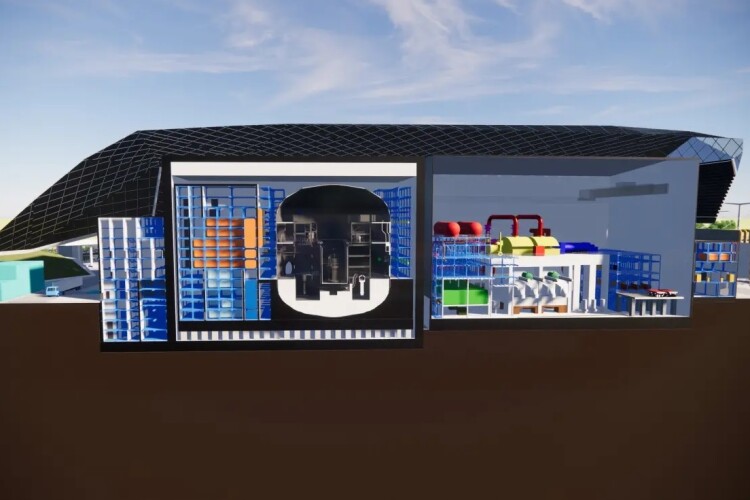
Reforms to planning are expected to open the way for the construction of a series of small modular reactors (SMRs) to be built across the country.
The government says that it is scrapping the current set list of eight potential sites for SMRs that it inherited from the previous government, meaning that they could potentially be built anywhere in England and Wales.
It is also removing the expiry date on nuclear planning rules, so that projects do not get timed out.
Developers will be encouraged to bring forward sites as soon as possible at the pre-application stage in the planning process, speeding up overall timelines.
Prime minister Keir Starmer said: “This country hasn’t built a nuclear power station in decades. we’ve been let down, and left behind. Our energy security has been hostage to Putin for too long, with British prices skyrocketing at his whims.
“I’m putting an end to it – changing the rules to back the builders of this nation, and saying no to the blockers who have strangled our chances of cheaper energy, growth and jobs for far too long. My government was elected to deliver change. I’ll take the radical decisions needed to wrestle Britain from its status quo slumber, to turbocharge our plan for change.”
Tom Greatrex, chief executive of the Nuclear Industry Association, said: “This is the prime minister’s strongest signal yet that new nuclear is critical to the growth and clean power mission. A more streamlined planning system will give certainty to investors, the supply chain and communities, and will enable us to get on with building new nuclear plants on more sites and at pace for a cleaner, more secure power system.
“We need to make Britain the best possible place to build new nuclear, both large-scale and SMRs, which means avoiding unnecessary stumbling blocks and ensuring regulations are proportionate to our urgent need for low carbon power, energy security and good jobs.”
Cathal O’Rourke, chief executive of Laing O’Rourke, one of the main contractors currently building Hinkley Point C in Somerset, said: “This announcement is a significant step forward for the UK’s nuclear industry. The clarity provided by these new planning rules, the focus on streamlining the regulatory process, and the emphasis on standardising reactor designs is precisely the sort of clear, unequivocal direction the industry needs.

“Having played a central role in delivering nuclear capacity at Hinkley Point C, we understand the complexities of these projects firsthand and these new measures, particularly around regulatory reform and streamlined planning, will be invaluable in ensuring future projects, like Sizewell C, can be delivered more efficiently and cost-effectively.
“In particular, standardisation and an industrialised approach will be key to driving down costs and accelerating construction timelines, ensuring we can deploy new nuclear capacity efficiently and at pace by adopting a ‘copy, improve, repeat’ approach to design and implementation. This type of approach would also improve worker welfare conditions on site from a physical and wellbeing perspective.
“This clear signal from government will unlock investment, create jobs nationwide for shared prosperity, including an ability to plan for long-term investment in apprenticeships, and ensure the UK can benefit from clean, locally supplied nuclear power for generations to come.”
Simone Rossi, UK chief executive of nuclear power generator EDF, the said: “As a major operator, investor and developer, EDF welcomes the proposals designed to speed up new nuclear projects in the UK and unlock economic growth.
“Nuclear is essential to a secure, low carbon energy system and is the ideal partner to renewables. There is a great opportunity to build new infrastructure across England and Wales, to replace aging stations and take advantage of available skills, existing grid connections and supportive communities.
“The opportunity will only be fully realised with the necessary reforms to planning and regulation, alongside continuing to build on the critical work at Hinkley Point C and Sizewell C to further develop skills and supply chains.”
Less impressed by the announcement was a campaign group seeking to block construction of the planned Sizewell C nuclear power station in Suffolk.
Stop Sizewell C said: “The words ‘nuclear power’ and ‘rips up rules’ do not belong in the same sentence. Given that not all the sites in the existing National Policy Statement are suitable for nuclear reactors, this further relaxation of planning rules is deeply concerning.
“We refute the government’s attempts to blame campaign groups for delays and cost increases at Sizewell C. You only have to look at Hinkley Point C (now £46bn in 2023 money and five years late) and EPR builds in France and Finland to realise that these projects can generate massive delays and overspends all by themselves. Sizewell C was expected to make a final investment decision in 2022 but has still not done so, primarily because there do not appear to be sufficient private investors willing to fund it.”
Got a story? Email news@theconstructionindex.co.uk
#Government #seeks #ease #small #modular #reactors